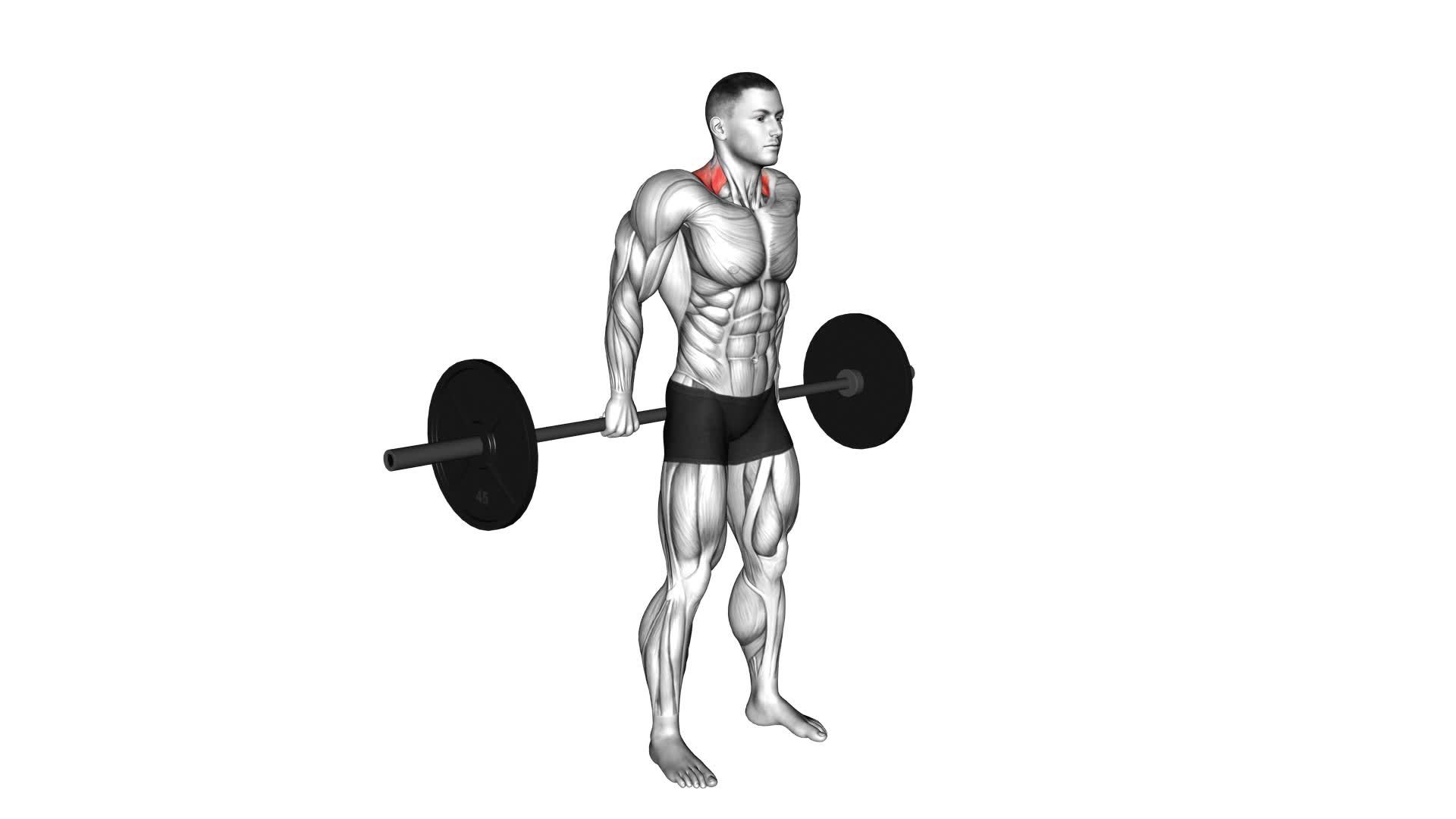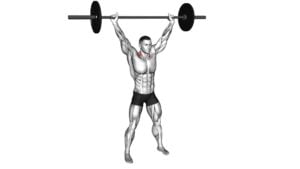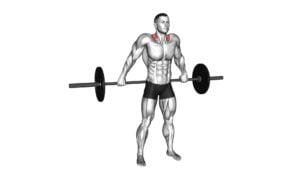Barbell Behind The Back Shrug – Video Exercise Guide & Tips

Are you looking to strengthen your upper back and improve your posture?
Watch This Exercise Video
The barbell behind the back shrug is the perfect exercise for you!
In this video exercise guide, we will show you the proper form and technique, as well as tips for increasing intensity and avoiding common mistakes.
Get ready to feel the burn and see results with this effective exercise.
Let's get started!
Key Takeaways
- Barbell Behind The Back Shrug increases trap development and improves posture.
- It targets and strengthens the upper back and shoulders, creating a more defined and sculpted upper back.
- Incorporating Barbell Behind The Back Shrug contributes to a balanced and aesthetically pleasing physique.
- To perform the exercise safely and effectively, it is important to focus on proper form, gradually increase intensity, and avoid common mistakes.
Benefits of Barbell Behind The Back Shrug
Get ready to experience the benefits of the Barbell Behind The Back Shrug exercise. This exercise is a great way to increase trap development and improve your posture. By incorporating this exercise into your workout routine, you can target and strengthen the muscles in your upper back and shoulders.
The Barbell Behind The Back Shrug specifically targets the traps, which are the muscles responsible for lifting and rotating the shoulder blades. By performing this exercise, you can effectively increase trap development and create a more defined and sculpted upper back. This can contribute to a more balanced and aesthetically pleasing physique.
Additionally, the Barbell Behind The Back Shrug is an excellent exercise for improving posture. Many people spend a significant amount of time sitting or hunched over, which can lead to rounded shoulders and a forward head posture. By regularly performing this exercise, you can strengthen the muscles that support proper posture and help alleviate these common postural imbalances.
To perform the Barbell Behind The Back Shrug, start by standing with your feet shoulder-width apart and your knees slightly bent. Hold a barbell behind your back, gripping it with an overhand grip. Then, lift your shoulders up towards your ears, squeezing your shoulder blades together. Hold for a moment, then lower the weight back down.
Incorporating the Barbell Behind The Back Shrug into your workout routine can have significant benefits for trap development and posture improvement. Add this exercise to your training program to reap the rewards and enhance your upper body strength and aesthetics.
Equipment Needed for Barbell Behind The Back Shrug
To perform the Barbell Behind The Back Shrug, you'll need a barbell and a comfortable grip. Here are some equipment-related discussion ideas:
- Barbell: Choose a barbell that's suitable for your strength and fitness level. Make sure it's sturdy and in good condition.
- Comfortable grip: Find a grip that works best for you. Some people prefer an overhand grip, while others find an underhand grip more comfortable. Experiment and see which grip feels most natural for you.
- Weight plates: Depending on your strength and goals, you can add weight plates to the barbell to increase the intensity of the exercise. Start with lighter weights and gradually increase as you become more comfortable and stronger.
- Weightlifting belt: If you prefer, you can use a weightlifting belt for additional support and stability during the exercise. This can be especially helpful if you're lifting heavy weights.
These are the essential equipment items needed to perform the Barbell Behind The Back Shrug.
Now, let's move on to discussing alternative exercises and variations of the barbell behind the back shrug.
Proper Form and Technique for Barbell Behind The Back Shrug
To perform the Barbell Behind The Back Shrug with proper form and technique, focus on maintaining a strong grip and engaging your shoulder and upper back muscles. This exercise offers several benefits, including improving shoulder strength.
To begin, stand with your feet shoulder-width apart and hold the barbell behind your back with an overhand grip. Keep your chest up and your core engaged throughout the movement. Bend your knees slightly for stability.
Next, lift your shoulders up towards your ears while keeping your arms straight. Avoid rolling your shoulders forward or backward. Hold the contraction for a brief moment, then lower the weight back down in a controlled manner.
Remember to breathe throughout the exercise. Inhale as you lift your shoulders and exhale as you lower the weight. Start with a lighter weight and gradually increase the load as you become comfortable with the movement.
Common Mistakes to Avoid During Barbell Behind the Back Shrug
When performing the barbell behind the back shrug, it's important to avoid making common mistakes that can hinder your progress and put you at risk of injury.
One common mistake is incorrect grip placement, which can limit the effectiveness of the exercise and strain your wrists.
Another mistake to avoid is rounding your shoulders, as this can lead to poor posture and decreased range of motion.
Incorrect Grip Placement
Do you know where to place your hands for the Barbell Behind the Back Shrug? Incorrect grip placement is a common mistake to avoid during this exercise. To ensure proper form and maximize the effectiveness of the exercise, keep the following in mind:
- Place your hands shoulder-width apart on the barbell.
- Avoid gripping the bar too tightly, as this can lead to excessive tension in your forearms and wrists.
- Maintain a firm grip throughout the exercise to prevent the barbell from slipping.
- Engage your grip strength by actively squeezing the barbell during the movement.
By using the correct grip placement, you can safely and effectively perform the Barbell Behind the Back Shrug.
Now, let's move on to the next section and discuss the importance of avoiding rounding the shoulders.
Rounding the Shoulders
Make sure you maintain proper posture and avoid rounding your shoulders during the Barbell Behind the Back Shrug for optimal results. Rounding the shoulders can lead to poor form and limit the benefits of the exercise.
To prevent this, focus on shoulder mobility and posture correction. Start by standing tall with your feet shoulder-width apart and your core engaged. As you perform the shrug, keep your shoulders back and down, avoiding any hunching or rounding forward. This will help activate the targeted muscles and prevent strain on the neck and upper back.
By maintaining proper shoulder alignment, you can maximize the effectiveness of the exercise and reduce the risk of injury.
Now let's move on to the next section where we discuss the importance of not neglecting proper form.
Neglecting Proper Form
To avoid compromising your form and maximizing the benefits of the Barbell Behind the Back Shrug, it's crucial to be mindful of common mistakes that can be made during this exercise. Neglecting proper form can lead to injuries and prevent you from fully reaping the benefits of this exercise.
Here are some key points to keep in mind:
- Avoid rounding your shoulders forward, as this can strain your neck and upper back.
- Maintain a neutral spine throughout the movement to protect your lower back.
- Don't lift the barbell with your arms. Instead, focus on using your traps and upper back muscles to perform the shrug.
- Keep your core engaged and avoid excessive leaning or swaying during the exercise to maintain stability and prevent injury.
Tips for Increasing Intensity and Progression in Barbell Behind The Back Shrug
To increase the intensity and progression in the Barbell Behind The Back Shrug, focus on gradually adding more weight to challenge your muscles further. Increasing the weight is one of the most effective ways to make the exercise more challenging and to continue making progress. Start with a weight that allows you to perform the exercise with proper form and gradually increase it as you get stronger. This will ensure that you're constantly pushing your muscles to adapt and grow.
Another way to increase the intensity of the Barbell Behind The Back Shrug is by incorporating tempo variation. Instead of performing the exercise with a standard tempo, try slowing down the movement on the way up and holding the contraction at the top for a few seconds before lowering the weight. This will place even more tension on your muscles and increase the time under tension, leading to greater muscle activation and growth.
Safety Precautions for Barbell Behind The Back Shrug
To ensure your safety while performing the Barbell Behind The Back Shrug, it's crucial to focus on proper form. Watch a demonstration or consult a trainer to learn the correct technique.
Additionally, be mindful of avoiding back injuries by not lifting too heavy or using improper form.
Lastly, warming up your muscles with exercises like shoulder rolls and neck stretches can help prevent strains or pulls during the exercise.
Proper Form Demonstration
Ensure proper form and safety when performing the barbell behind the back shrug by following these guidelines:
- Stand with your feet shoulder-width apart and hold the barbell with an overhand grip behind your back.
- Keep your back straight, shoulders relaxed, and engage your core.
- Lift your shoulders up towards your ears, squeezing your shoulder blades together.
- Hold the shrug for a second and then slowly lower your shoulders back down.
By demonstrating proper form, you can maximize the benefits of the barbell behind the back shrug. This exercise targets the upper trapezius muscles, helping to improve posture and strengthen the upper back. Additionally, it can increase shoulder stability and enhance overall upper body strength. By focusing on technique, you reduce the risk of injury and ensure that you're getting the most out of your workout.
Now, let's move on to the next section where we'll discuss how to avoid back injuries.
Avoiding Back Injuries
How can you safely avoid back injuries while performing the barbell behind the back shrug?
Preventing back pain and strengthening your back muscles are crucial for a safe and effective workout. To avoid injuries, start by ensuring that your form is correct. Keep your back straight and engage your core throughout the exercise.
It's also important to use an appropriate amount of weight that you can handle without straining your back. Gradually increase the weight as your back muscles get stronger.
Additionally, warm up before starting the exercise to prepare your muscles for the workout. This will help reduce the risk of injury.
By following these safety precautions, you can minimize the chances of back injuries and maximize the benefits of the barbell behind the back shrug.
Now, let's move on to some recommended warm-up exercises.
Recommended Warm-Up Exercises
To safely warm up and prepare your muscles for the barbell behind the back shrug, incorporate these recommended exercises into your routine:
- Arm Circles: Stand with your feet shoulder-width apart. Extend your arms out to the sides and make small circles with your arms, gradually increasing the size of the circles. Do this for 30 seconds in each direction.
- Shoulder Rolls: Stand with your feet shoulder-width apart. Roll your shoulders forward in a circular motion, making large circles. After 15 seconds, switch to rolling your shoulders backward. Repeat this exercise for 30 seconds.
- Neck Rolls: Stand with your feet shoulder-width apart. Slowly roll your head in a circular motion, starting from one side and moving to the other. Repeat this exercise for 30 seconds.
- Trunk Rotations: Stand with your feet shoulder-width apart. Place your hands on your hips and rotate your upper body from one side to the other. Repeat this exercise for 30 seconds.
These dynamic stretching exercises will help increase blood flow to your muscles, improve flexibility, and reduce the risk of injury during the barbell behind the back shrug. Incorporate them into your warm-up routine to ensure a safe and effective workout.
Frequently Asked Questions
How Many Sets and Reps Should I Do for the Barbell Behind the Back Shrug?
To get the most out of the barbell behind the back shrug, it's important to know how many sets and reps to do.
This exercise is great for targeting your traps and building upper body strength.
For optimal results, aim for 3-4 sets of 12-15 reps.
This will help you develop strong and defined shoulder and back muscles.
Remember to start with lighter weights and gradually increase as you get comfortable.
Can I Perform the Barbell Behind the Back Shrug With Dumbbells Instead of a Barbell?
Yes, you can perform the barbell behind the back shrug with dumbbells instead of a barbell. This exercise has dumbbell variations that offer similar benefits to the barbell version.
The behind the back shrug targets the trapezius muscles and helps improve upper body strength and posture. Using dumbbells allows for better control and range of motion.
Start with lighter weights and gradually increase as you get comfortable with the movement.
Is It Necessary to Use a Lifting Belt for the Barbell Behind the Back Shrug?
Using a lifting belt for the barbell behind the back shrug can provide benefits like added stability and support for your lower back.
It can help prevent injuries and allow you to lift heavier weights.
However, it isn't necessary to use a lifting belt for this exercise.
Can I Incorporate the Barbell Behind the Back Shrug Into My Shoulder Workout Routine?
Yes, you can definitely incorporate the barbell behind the back shrug into your shoulder workout routine.
To ensure proper form and technique, start by standing with your feet shoulder-width apart and the barbell resting behind your back on your traps.
Keep your back straight and engage your core as you shrug your shoulders up towards your ears.
To progress and increase the weight, gradually add more weight to the barbell as you become stronger.
Should I Perform the Barbell Behind the Back Shrug at the Beginning or End of My Workout?
The ideal time to perform the Barbell Behind The Back Shrug depends on your workout goals. If you want to prioritize your traps and upper back, it's best to do it towards the beginning of your workout when you have more energy.
However, if you want to focus on your shoulders, you can perform it towards the end of your workout as a finishing exercise. Remember, there are variations of the Barbell Behind The Back Shrug that can target different muscle groups.
Conclusion
In conclusion, the barbell behind the back shrug is a highly effective exercise for targeting and strengthening the muscles in your upper back and shoulders. By following proper form and technique, avoiding common mistakes, and gradually increasing intensity, you can maximize the benefits of this exercise.
Remember to always prioritize safety by using the appropriate equipment and listening to your body's limits. Incorporate the barbell behind the back shrug into your workout routine to improve your overall strength and posture.

Author
Years ago, the spark of my life’s passion ignited in my mind the moment I stepped into the local gym for the first time. The inaugural bead of perspiration, the initial endeavor, the very first surge of endorphins, and a sense of pride that washed over me post-workout marked the beginning of my deep-seated interest in strength sports, fitness, and sports nutrition. This very curiosity blossomed rapidly into a profound fascination, propelling me to earn a Master’s degree in Physical Education from the Academy of Physical Education in Krakow, followed by a Sports Manager diploma from the Jagiellonian University. My journey of growth led me to gain more specialized qualifications, such as being a certified personal trainer with a focus on sports dietetics, a lifeguard, and an instructor for wellness and corrective gymnastics. Theoretical knowledge paired seamlessly with practical experience, reinforcing my belief that the transformation of individuals under my guidance was also a reflection of my personal growth. This belief holds true even today. Each day, I strive to push the boundaries and explore new realms. These realms gently elevate me to greater heights. The unique combination of passion for my field and the continuous quest for growth fuels my drive to break new ground.







